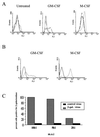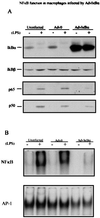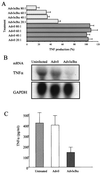Efficient adenoviral infection with IkappaB alpha reveals that macrophage tumor necrosis factor alpha production in rheumatoid arthritis is NF-kappaB dependent
- PMID: 9653166
- PMCID: PMC20955
- DOI: 10.1073/pnas.95.14.8211
Efficient adenoviral infection with IkappaB alpha reveals that macrophage tumor necrosis factor alpha production in rheumatoid arthritis is NF-kappaB dependent
Abstract
Tumor necrosis factor (TNF) alpha has been shown to be a major therapeutic target in rheumatoid arthritis with the success of anti-TNFalpha antibody clinical trials. Although signaling pathways leading to TNFalpha expression have been studied in some detail, there is evidence for considerable differences between individual cell types. This prompted us to investigate the intracellular signaling pathways that result in increased TNFalpha synthesis from macrophages in the diseased synovial joint tissue. Using an adenoviral system in vitro we report the successful delivery of genes to more than 95% of normal human macrophages. This permitted us to show, by using adenoviral transfer of IkappaB alpha, the natural inhibitor of NF-kappaB, that induction of TNFalpha in normal human macrophages by lipopolysaccharide, but not by some other stimuli, was inhibited by 80%. Furthermore the spontaneous production of TNFalpha from human rheumatoid joint cell cultures was inhibited by 75%, indicating that the NF-kappaB pathway is an essential step for TNFalpha synthesis in synovial macrophages and demonstrating that NF-kappaB should be an effective therapeutic target in this disease.
Figures





Similar articles
-
Evidence that rheumatoid arthritis synovial T cells are similar to cytokine-activated T cells: involvement of phosphatidylinositol 3-kinase and nuclear factor kappaB pathways in tumor necrosis factor alpha production in rheumatoid arthritis.Arthritis Rheum. 2002 Jan;46(1):31-41. doi: 10.1002/1529-0131(200201)46:1<31::AID-ART10029>3.0.CO;2-5. Arthritis Rheum. 2002. PMID: 11822409
-
Responses to the proinflammatory cytokines interleukin-1 and tumor necrosis factor alpha in cells derived from rheumatoid synovium and other joint tissues involve nuclear factor kappaB-mediated induction of the Ets transcription factor ESE-1.Arthritis Rheum. 2003 May;48(5):1249-60. doi: 10.1002/art.10942. Arthritis Rheum. 2003. PMID: 12746898
-
Defining therapeutic targets by using adenovirus: blocking NF-kappaB inhibits both inflammatory and destructive mechanisms in rheumatoid synovium but spares anti-inflammatory mediators.Proc Natl Acad Sci U S A. 1999 May 11;96(10):5668-73. doi: 10.1073/pnas.96.10.5668. Proc Natl Acad Sci U S A. 1999. PMID: 10318942 Free PMC article.
-
Cytokine blockade in rheumatoid arthritis.Adv Exp Med Biol. 2001;490:119-27. doi: 10.1007/978-1-4615-1243-1_13. Adv Exp Med Biol. 2001. PMID: 11505970 Review.
-
Nuclear factor kappaB (NF-kappaB) pathway as a therapeutic target in rheumatoid arthritis.J Korean Med Sci. 1999 Jun;14(3):231-8. doi: 10.3346/jkms.1999.14.3.231. J Korean Med Sci. 1999. PMID: 10402163 Free PMC article. Review.
Cited by
-
Transcriptional control of the TNF gene.Curr Dir Autoimmun. 2010;11:27-60. doi: 10.1159/000289196. Epub 2010 Feb 18. Curr Dir Autoimmun. 2010. PMID: 20173386 Free PMC article. Review.
-
High-efficiency gene transfer into nontransformed cells: utility for studying gene regulation and analysis of potential therapeutic targets.Arthritis Res. 2002;4 Suppl 3(Suppl 3):S215-25. doi: 10.1186/ar560. Epub 2002 May 9. Arthritis Res. 2002. PMID: 12110141 Free PMC article. Review.
-
Streptococcal cell wall induced arthritis: leukocyte activation in extra-articular lymphoid tissue.Inflammation. 2003 Apr;27(2):59-70. doi: 10.1023/a:1023215515617. Inflammation. 2003. PMID: 12797545
-
Ehrlichia chaffeensis induces monocyte inflammatory responses through MyD88, ERK, and NF-κB but not through TRIF, interleukin-1 receptor 1 (IL-1R1)/IL-18R1, or toll-like receptors.Infect Immun. 2011 Dec;79(12):4947-56. doi: 10.1128/IAI.05640-11. Epub 2011 Sep 19. Infect Immun. 2011. PMID: 21930764 Free PMC article.
-
High avidity autoreactive T cells with a low signalling capacity through the T-cell receptor: central to rheumatoid arthritis pathogenesis?Arthritis Res Ther. 2008;10(4):210. doi: 10.1186/ar2446. Epub 2008 Jul 24. Arthritis Res Ther. 2008. PMID: 18710589 Free PMC article. Review.
References
Publication types
MeSH terms
Substances
Grants and funding
LinkOut - more resources
Full Text Sources
Other Literature Sources
Medical

